Dive Brief:
- States with Democratic governors or state boards of education are more often appointing district superintendents or administrators to the role of state education superintendent, while Republican-led states are split between choosing district administrators and state education agency leaders for the top education job, according to an analysis from ILO Group, a national education strategy and policy firm.
- Republican state leaders are much more likely than Democrats to choose someone with a political background for the top state education job, with Republicans showing a growing emphasis on addressing cultural issues in schools. ILO Group said its research demonstrates that elected leaders of both parties often use the selection of state superintendents to make political statements and advance political priorities.
- In the next two years, there will be elections for 24 gubernatorial and state education board elections. Those newly elected leaders will look to make changes or reappoint state superintendents.
Dive Insight:
The state superintendent is one of the most high-profile education positions in state government, and the person's selection sends a message about the likely future direction for state public policy, ILO Group said in a brief about its research.
"Partisan differences in candidate selection, the effect changing politics in state education systems have on those choices, and a strong insular preference for ‘homegrown’ candidates all demonstrate clear trends in the messages leaders are sending about their selection of state superintendents," the brief said.
The analysis looked at the 39 states and the District of Columbia that currently have governors or state boards of education with partisan affiliations who are responsible for state superintendent appointments. The other 12 states elect their state education superintendent.
Other research findings include:
- Of the last two permanent and interim state superintendents chosen by governors and elected state boards in each state, 42% had been district leaders and 31% had been state education administrators.
- Democratic-led states were more likely to choose district leaders for the state's top education job, followed by state education administrators and candidates who work in higher education. Republican-led states were likely to appoint state education administrators, followed by district administrators and elected state legislators and political aides.
- Republicans more frequently chose elected state legislators or political aides (22% of the time) compared to Democrats (3%).
- Both political parties favor making in-state appointments for state superintendent, as opposed to hiring candidates from outside of the state. This likely points to the preference of people who are familiar with the state's dynamics, contexts and priorities.








 Dive Awards
Dive Awards







